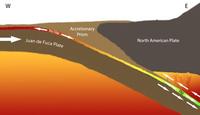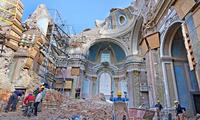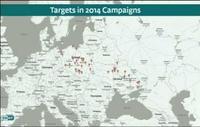-
"Slow slip events" could help in predicting magnitude of earthquakes, tsunamis

Earthquakes and tsunamis can be giant disasters no one sees coming, but now an international team of scientists has found that subtle shifts in the earth’s offshore plates can be a harbinger of the size of the disaster. The team reports that a geological phenomenon called “slow slip events,” identified just fifteen years, ago is a useful tool in identifying the precursors to major earthquakes and the resulting tsunamis. The scientists used high precision GPS to measure the slight shifts on a fault line in Costa Rica, and say better monitoring of these small events can lead to better understanding of maximum earthquake size and tsunami risk.
-
-
Low-lying island nations say rising seas levels spell doom
The president of the Seychelles on last week urged the Earth’s small island nations to unite for a campaign against climate change — or else drown. The call came at the start of a two-day summit of the Alliance of Small Island States (AOSIS), a coalition of small islands and low-lying coastal countries, ahead of global climate talks which will take place in Lima, Peru, in December. Low-lying island nations, some of which are little more than one meter (three feet) above sea level, are regarded as among the most vulnerable to rising sea levels, which is one of the manifestations of global warming.
-
-
New app turns smartphones into sensors for an earthquake early-warning system
The MyShake app, still in test mode, uses smartphone accelerometers and locators to augment the data on incoming quakes issued by the 400 seismometers which are part of California’s ShakeAlert program.Registered phones act as additional earthquake sensors, as the app runs an algorithm which detects when the phone is still or shaking. Should several registered phones in the same area begin to shake at the same time, an earthquake alert is issued.
-
-
Court overturns manslaughter conviction of seismologists over 2009 L'Aquila quake

An appeals court in Italy on Monday overturned manslaughter convictions of six of the seven natural disaster experts and seismologists who faced prison sentences for what a lower court described as having falsely reassured residents ahead of a 2009 earthquake which killed 309 people in the central Italy city of L’Aquila. The 2012 ruling was met with outrage and dismay by the scientific community, which argued that the convictions were based on a complete misunderstanding of the science used to calculate the probability of an earthquake. Leasing scientists warned that the case could prevent scientists from offering potentially life-saving advice on natural disasters in the future.
-
-
Security experts worry BlackEnergy technology could soon be available to bad non-state actors

DHS a few days ago has issued a cyberthreat alert to critical infrastructure firms warning of the malicious software called BlackEnergy, a variant of a Trojan horse believed to have originated from Russian government-sponsored hackers. BlackEnergy is similar to another Russian issued malware called Sandworm, which was used in a 2013 Russian cyber-espionage campaign against NATO, the European Union, and overseas telecommunication and energy assets. DHS believes the attack on U.S. critical systems is “part of a broader campaign by the same threat actor.”
-
-
U.S. government networks vulnerable despite billons spent on protecting them
Experts say that cybersecurity has leaped over terrorism as the top threat to U.S. security, and with the awareness of the threat comes funding better to secure government systems. There are currently 90,000 information technology security professionals working for the government, 33 percent of them are contractors. The federal government is projected to hire more cyber professionals and spend $65 billion on cybersecurity contracts between 2015 and 2020, but today, federal cybersecurity officials are still struggling to keep sensitive data from hackers and cyber criminals. Some have warned of a “Cyber Pearl Harbor” — but Pearl Harbor was a surprise. No one in business or government today can continue to plead surprise when it comes to the possibility of cyberattack.
-
-
Information sharing is key in responding to cyberattacks
Time is not your friend when your information systems are under cyberattack, but sharing threat information before, during, and after an attack with a trusted group of peers can help. Not only does it alert the other members of your community to a potential attack, it can provide critical actionable information to speed and bolster your own defenses. Participating in a formal information sharing group can greatly enhance an organization’s cybersecurity capabilities.
-
-
Sea level rise threatens California coastal infrastructure
Officials in Humboldt County, California are preparing for sea level rise, which experts say could threaten utilities and U.S. highway 101. The National Research Councilwarns that California, Oregon, and Washington could experience twelve inches of sea level rise by 2050 and thirty-six inches by 2100. Sea level on Humboldt Bay has increased by eighteen inches over the past century due to increasing tide elevation and subsidence. Gas, electrical, and water transmission lines are all buried in the farmlands behind dikes that fortify the shoreline.
-
-
Russian government hackers insert malware in U.S. critical infrastructure control software
Investigators have uncovered a Trojan Horse named BlackEnergy in the software that runs much of the U.S. critical infrastructure. In a worst case scenario, the malware could shut down oil and gas pipelines, power transmission grids, water distribution and filtration systems, and wind turbines, causing an economic catastrophe. Some industry insiders learned of the intrusion last week via a DHS alert bulletin issued by the agency’s Industrial Control Systems Cyber Emergency Response Team(ICS-CERT). The BlackEnergy penetration had recently been detected by several companies. Experts say Russia has placed the malware in key U.S. systems as a threat or a deterrent to a U.S. cyberattack on Russian systems – mutual assured destruction from a cold war-era playbook.
-
-
NASA facilities across U.S. vulnerable to climate change
The National Aeronautics and Space Administration (NASA) has been at the forefront of climate science, launching satellites that take the pulse of Earth’s land, oceans, and atmospheric systems, gathering data on climate, weather, and natural hazards. The agency, however, is itself increasingly vulnerable to the effects of a changing climate. Hurricane Isabel partially flooded the Langley Research Center in Virginia in 2003; Hurricane Frances damaged the Kennedy Space Center in Florida in 2004; and Hurricane Katrina damaged buildings at the Stennis Space Center in Mississippi in 2005, among recent incidents. Other facilities have been damaged or threatened by tornadoes and wildfires.
-
-
Harnessing artificial intelligence to search for new Ebola treatments
The University of Toronto, Chematria, and IBM are combining forces in a quest to find new treatments for the Ebola virus. Using a virtual research technology invented by Chematria, a startup housed at U of T’s Impact Center, the team will use software that learns and thinks like a human chemist to search for new medicines. Running on Canada’s most powerful supercomputer, the effort will simulate and analyze the effectiveness of millions of hypothetical drugs in just a matter of weeks.
-
-
Standardizing small, self-sustaining electric microgrids
When Department of Energy and Oak Ridge National Laboratory researchers talk about “islanding,” or isolating, from the grid, they are discussing a fundamental benefit of microgrids — small systems powered by renewables and energy storage devices. The benefit is that microgrids can disconnect from larger utility grids and continue to provide power locally.
-
-
Lights out: Experts say instability of world’s power supplies must be urgently addressed
A new study reveals the urgent need to address instabilities in the supply of electrical power to counteract an increase in the frequency and severity of urban blackouts. The work builds on previous studies which examined a sharp increase in electrical usage over recent years, and warned the world to prepare for the prospect of coping without electricity as instances of complete power failure become increasingly common.
-
-
A major cyberattack causing widespread harm to national security is imminent: Experts

A new report found that more than 60 percent of the roughly 1,600 computer and Internet experts surveyed on the future of cyberattacks believe a nationwide cyberattack is imminent. They did so in response to the question: “By 2025, will a major cyberattack have caused widespread harm to a nation’s security and capacity to defend itself and its people?” The experts also warn about the risks to privacy which will accompany a growing focus on cybersecurity.
-
-
Coastal towns build resilience to prepare for future storms
Sea Bright, New Jersey is one of several communities affected by Superstorm Sandy which is actively building resiliency against the next major storm. The town, set on a narrow strip of sand between the Atlantic Ocean and the Shrewsbury River, frequently floods, and during Sandy, its entire downtown business district was damaged, as were 75 percent of the town’s homes.
-
- All
- Regional
- Water
- Biometrics
- Borders/Immig
- Business
- Cybersecurity
- Detection
- Disasters
- Government
- Infrastructure
- International
- Public health
- Public Safety
- Communication interoperabillity
- Emergency services
- Emergency medical services
- Fire
- First response
- IEDs
- Law Enforcement
- Law Enforcement Technology
- Military technology
- Nonlethal weapons
- Nuclear weapons
- Personal protection equipment
- Police
- Notification /alert systems
- Situational awareness
- Weapons systems
- Sci-Tech
- Sector Reports
- Surveillance
- Transportation
Advertising & Marketing: advertise@newswirepubs.com
Editorial: editor@newswirepubs.com
General: info@newswirepubs.com
2010-2011 © News Wire Publications, LLC News Wire Publications, LLC
220 Old Country Road | Suite 200 | Mineola | New York | 11501
Permissions and Policies
Editorial: editor@newswirepubs.com
General: info@newswirepubs.com
2010-2011 © News Wire Publications, LLC News Wire Publications, LLC
220 Old Country Road | Suite 200 | Mineola | New York | 11501
Permissions and Policies
